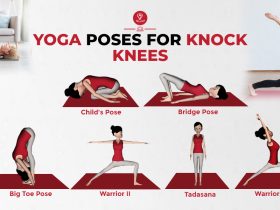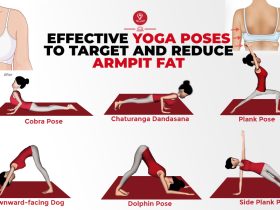
Knees to Chest Pose aka Apanasana performed in the supine position and is also a wonderful way to release the low back. It is a great yoga pose for beginners as it is associated with more benefits rather than just relaxing the body. It is often performed at the end of back stretching poses as it has simple, relaxing, and calming effects.
Apanasana Yoga Basics
| Sanskrit Pronunciation | Apanasana (ah-pahn-AHS-uh-nuh) |
| Meaning | Apana” meaning, “downward-flowing life force” “asana” meaning, “pose |
| Pose Type | Supine position, back stretching pose |
| Pose Level | Beginner’s level |
| Style of yoga | – |
| Other Names | Knees-to-Chest Pose, wind relieving pose or eliminating force posture |
| Stretches | The spine, the gluteus maximus, and the biceps femoris |
| Strengthening | The back and the cervical spine |
| Duration | 30 second to 3 minutes |
Meaning
A classic yoga posture, Apasana is a Sanskrit name, which is made up of two words – “Apana” + “asana”
“Apana” (meaning, “downward-flowing life force”) and “asana” (meaning, “pose”).
As in Apanasana, one presses the spine to the floor while extending the knees to the chest, wrapping the arms around the calves, and giving a reassuring short massage to the abdominal organs, which actually works on the internal organs and the digestive system. Known to have benefits, and help move toxins downstream, stimulate the organs, and release stress from the body.
Apart from this, it is very effective with back strain after a long day of sitting at your desk, relaxing the muscles of the back, and the tense muscles of the neck and thighs.
Practice Guide For Apanasana Yoga
The practice guide to perform Knees-to-Chest Pose serves as a valuable resource for yoga enthusiasts seeking to advance their practice, offering a structured and detailed approach to mastering this asana.
Preparatory Poses
- Supine Spinal Twist Pose (Supta Matsyendrasana)
- Half Wind Release Pose (Ardha Pawanamuktasana)
Steps to Do Apanasana
- To do this asana, first, lie down on your back and keep your feet on the floor by bending your knees.
- Now lift both your legs and bring the knees near the chest.
- Now bend from the knees and take them in the circles of your arms.
- While exhaling, press the knees to the chest.
- Stay in this posture for as long as you can, then while exhaling, straighten the legs.
- In the beginning, do it for some time according to the capacity and then come to a normal state while breathing.
Follow-up poses
- Reclining Bound Angle Pose (Supta Baddha Konasana)
- Fish Pose (Matsyasana)
- Corpse Pose (Savasana)
Apanasana Variations
Pawanmuktasana – In this variation, after attaining Apanasana, try to touch your nose to the knees, for this, lift your head and neck. Then, draw the nose in towards the knees.
Eka pada apanasana (Half Apanasana) – Here, lie in the supine pose as Apasana. Then, bend one knee and brings it towards the chest. The hands are clasped around the shin. Then, switch the leg.
Benefits
1. Strengthens the back – Apanasana is very helpful to avoid back pain. The practice of this asana expands the back muscles, which provides relief from back pain and strengthens the back. If you work sitting in one place for 8 to 10 hours a day, then you must practice Apanasana.
2. Massages the digestive organs – The benefits of Apanasana are also very good for keeping the digestive system strong. Its regular practice massages the digestive organs and gently squeezes the internal organs, allowing the digestive system to function optimally.
3. Relieves stress – By the practice of this asana, the mind remains focused, the mind remains calm and mental problems like stress, insomnia, and anxiety are removed.
4. Improves blood circulation – The pressure on the back and abdomen helps to bring a fresh supply of blood to the muscles and internal organs.
Precautions
- If you already have severe back pain or back pain, do not practice this asana.
- Never practice Pawanmuktasana immediately after eating food.
- Do not practice this asana even during pregnancy.
- If you have a neck injury or pain, do not try to raise your head. Let the head remain on the ground.
- Sciatica patients should also not practice this asana.
Conclusion
Apanasana is a relaxing supine asana often perform in lie back and both knees in toward the chest, with the legs and feet together.
Known for its benefits on the internal organs, as well as its elimination of fatigue, stress, and toxins in the body and digestive system.
RELATED ARTICLES
May 20, 2025
Kegel Exercises: Strengthen Your Pelvic Floor for Better Health
Kegel exercises strengthen the pelvic floor muscles, which support the uterus, bladder, small intestine and rectum. Strengthening these muscles improves[...]
Oct 06, 2024
Balance Your Body: Yoga Poses For Knock Knees (Genu Valgum)
Knock knees, or “genu valgum,” is a condition in which the knees touch each other while the ankles remain apart.[...]
Sep 20, 2024
Effective Yoga Poses to Target and Reduce Armpit Fat
Fat accumulation under the arms is a common problem for many women, which is often considered an important part of[...]
RECENT POSTS
Disclaimer
The content is purely informative and educational in nature and should not be construed as medical advice. Please use the content only in consultation with an appropriate certified medical or healthcare professional






